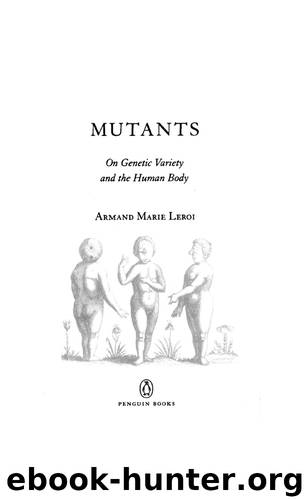Mutants by Armand Marie Leroi

Author:Armand Marie Leroi [Leroi, Armand Marie]
Language: eng
Format: epub, mobi
ISBN: 9781101562765
Publisher: Penguin Group US
Published: 2005-01-24T16:00:00+00:00
VIII
A FRAGILE BUBBLE
[ON SKIN]
OUR SPECIES HAS, SINCE 1758, borne the flattering, if not always accurate, name Homo sapiens – thinking Man. At least that is what the Swedish naturalist Carl Linnaeus called us in the tenth edition of his Systema naturae, the work which tax-onomists even now accept as the first authoritative source of the names which they have given the world’s creatures. It was nearly otherwise. In Linnaeus’ text, directly adjacent to the word ‘sapiens‘ is another designation, an apparent synonym for ourselves, yet one that is somehow never explained: ‘H. diurnus’ – Man of the day. It is a name that seems to have had particular resonance for Linnaeus. His notebooks show that he toyed with sapiens vs. diurnus for much of his life, and it is only in the tenth edition that the latter is firmly relegated to second place. On the face of it, Linnaeus’ belief that diurnality captured something special about our species is puzzling. Although we are undoubtedly daylight-loving creatures, so too are many others. It is only when one pages through the staggered typography and compressed Latin of Linnaeus’ text that one finds the explanation for his diurnal dreams. Linnaeus, godfather to humanity, believed that we were not alone.
OCULOCUTANEOUS ALBINISM TYPE II. ZULU MAN, NATAL. FROM KARL PEARSON ET AL. 1913 A monograph on albinism in man.
Long before palaeontologists unearthed from Serengeti dongas the bones of our extinct Hominid cousins, Linnaeus believed that the remoter parts of the world were peopled by other species of humans. He was not thinking about the humans who lived in Asia, Africa or the New World; they clearly belonged to the same species as himself. He was thinking of something altogether more exotic: a species of human that was bowed and shrunken in form, that had short curly hair rather like an African’s, only fair, that had skin as white as chalk and slanted golden eyes. With eyesight as poor by day as it was acute by night, they were crepuscular, cavern-dwelling creatures who emerged at dusk to raid the farms of their more intelligent cousins. They were ancient; perhaps they had even ruled the earth before Man, but now they were on the retreat. This species, Linnaeus said, was ‘a child of darkness which turns day into night and night into day and appears to be our closest relative’. True, he had never seen one, but had not Pliny and Ptolemy written of the Leucaethopes? And had they not been seen more recently, not least by his own students, in Ethiopia, Java, the Ternate Islands and Mount Ophir of Malacca? The reports seemed vivid and precise: in Ceylon they were called Chacrelats; in Amboina, Kakurlakos – from the Dutch for ‘cockroach’; and everywhere they were despised. This was enough for Linnaeus, and true to his classifier’s instinct, he gave them a name: Homo troglodytes – cave-dwelling Man. And next to that he wrote ‘H. nocturnus’ – Man of the night.
What was Linnaeus thinking of? As the
Download
This site does not store any files on its server. We only index and link to content provided by other sites. Please contact the content providers to delete copyright contents if any and email us, we'll remove relevant links or contents immediately.
The Leavers by Lisa Ko(6489)
Born to Run: by Christopher McDougall(6278)
iGen by Jean M. Twenge(4705)
Sapiens by Yuval Noah Harari(4551)
The Kite Runner by Khaled Hosseini(4472)
Spare by Prince Harry The Duke of Sussex(4222)
Bullshit Jobs by David Graeber(3190)
Livewired by David Eagleman(3133)
Goodbye Paradise(2976)
Never by Ken Follett(2905)
A Dictionary of Sociology by Unknown(2521)
Harry Potter 4 - Harry Potter and The Goblet of Fire by J.K.Rowling(2419)
The Club by A.L. Brooks(2372)
People of the Earth: An Introduction to World Prehistory by Dr. Brian Fagan & Nadia Durrani(2352)
The Social Psychology of Inequality by Unknown(2316)
Machine Learning at Scale with H2O by Gregory Keys | David Whiting(2316)
Harry Potter and the Order of the Phoenix (5) by J.K. Rowling(2233)
0041152001443424520 .pdf by Unknown(2228)
Harry Potter and the Deathly Hallows (7) by J.K. Rowling(2223)
